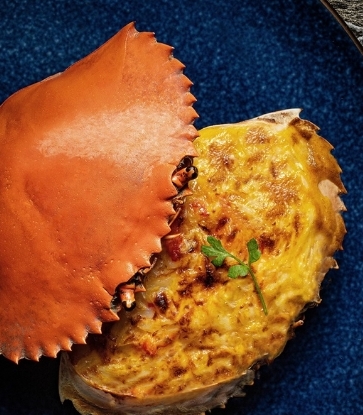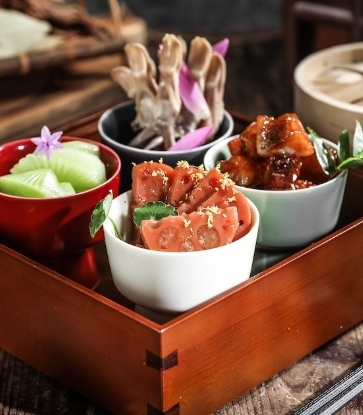In the past, white sugar sponge cakes, fermented bean curd puffs and wife cakes were very common Cantonese breakfast pastries and cakes that made daily appearances at yum cha restaurants. There are stringent standards to follow—both in terms of technique and ingredients—when making these pastries and cakes, so they are gradually disappearing from menus of shops and restaurants in Hong Kong.
For some chefs of MICHELIN-starred Chinese restaurants, keeping these traditional cakes and pastries on the menu is neither a hunger marketing tactic nor an attempt to glorify them into objects of luxury; they simply believe that if customers are given the chance to understand the craftsmanship behind these traditional creations, they will be able to appreciate their food at a deeper level. This may also attract more chefs to learn and hone this slowly-disappearing craft.
REALTED: 5 Must-Order Dishes At Luk Yu Tea House, A MICHELIN Celebration Of Well-Preserved Cantonese Classics

“Old yum cha restaurants, such as Iun Loi Restaurant (a restaurant in Macau no longer in operation), all had an in-house Chinese pastry section. So when I went yum cha as a kid with my family, we were able to enjoy all kinds of Chinese pastries, like wife cakes and century egg pastries,” says Chan Hon-cheong, Executive Chinese chef of One Harbour Road in Wan Chai’s Grand Hyatt. Chef Chan is originally from Macau, and there’s excitement in his eyes that cannot be concealed when he talks about his childhood. Walnut cookies are one of his favourites. “They look like cookies, but the texture is so light and airy. I just can’t stop eating them!” He says that Cantonese biscuits used to be sold in shops as weekly specials. “In the old days, for restaurants to gain a competitive edge, a person was hired in the kitchen to come up with weekly special sweets to attract customers.”
RELATED: Ask A Sommelier: How To Pick The Perfect Wine For A Cantonese Meal


Yum cha restaurants in the past always served up pastries in two large pieces per plate. This is quite different for Chinese restaurants located inside hotels, where pastries are often made to be dainty and bite-sized, which is a test of the chef’s skills. Chef Chan recalls that in the 1980s, high-end hotels such as Regent Hotel and Grand Hyatt all made these kinds of Cantonese pastries in-house, but later when the older-generation chefs left, the new apprentices were only interested in making western-style desserts. Nowadays there are only very few chefs that specialise in Cantonese pastries, but chef Chan is determined to continue making them in hopes of reigniting an interest among young people.
(Pictured left: One Harbour Road’s signature fermented bean curd puffs with a lotus seed paste filling.)

One Harbour Road’s current dessert menu features traditional sweet treats such as baked puff pastry with winter melon paste (also known as wife cakes) and preserved egg pastries with young ginger, which chef Chan thinks are rather difficult to make. He says that Cantonese pastries can be categorised as being “visible” or “hidden”, which describe the layers of puff pastry and whether they are visible without having to cut open the piece. “Cantonese-style pastries tend to be more restrained, and are usually ‘hidden pastries’. You need to be quick and accurate when laminating the dough; using subtle wrist strength is the best way to get the dough smooth, even and perfectly combined with the soft filling.” Lard also helps to give the puff pastry a crispier yet melt-in-the-mouth texture. “You can see it: crusts with lard are more solid and don’t fall apart easily.” The restaurant’s signature deep-fried fermented bean curd pastries with lotus paste are made using this method.
(Picture right: Chan Hon-cheong, executive Chinese chef of One Harbour Road. Image provided by Grand Hyatt Hong Kong.)

For Li Chi-wai, executive chef at Rosewood Hong Kong’s Chinese restaurant The Legacy House, savouring Cantonese-style cakes is like studying Guangzhou’s culture, its people, and the locals’ philosophy of slow living.
“Have you seen a sesame pod?” Chef Li asks as he brings over a plate of black sesame rolls. He grew up in Guangzhou, and has seen how farmers harvest sesame the same way they harvest rice crops, then dry them under the sun. “This way the sesame seeds can dry thoroughly and produce the strongest fragrance.” For the black sesame rolls, chef Li insists on using sun-dried sesame seeds from Guangzhou. From light roasting, cooling and wok-frying, to slow-grinding and straining, he takes the time to get all the details right. The kind of black sesame roll that gets his stamp of approval must look black and glossy, and should be fragrant and smooth. Even with the many new flavours created in recent years—almond juice, orange juice, hawthorn fruit—chef Li still likes black sesame the best. “It’s the memory of the people of Guangzhou!”
RELATED: Suzhou Style Mooncakes : a story told by the chef of a Michelin-starred Zhejiang Restaurant


Chef Li comes from Xinhui in Guangdong, which may explain his obsession with steamed white sugar pudding—an everyday tea snack of the neighbouring Shunde district—despite it being even harder to make than black sesame rolls. He had to specially cultivate a natural yeast; the process is not unlike western chefs making sourdough starter. For three months, he spent every day experimenting with growing yeast by adjusting the acidity, alkaline levels and humidity. Chef Li trusts his own hands and instincts the most. “The starter has a nice warmth, and that’s its best state.”
(Pictured left: Li Chi-wai, executive chef at The Legacy House. Image provided by Rosewood Hong Kong.)

Not only are the two chefs reviving Cantonese classics, they are also hoping to inject their guests’ lives with a sense of ceremony through good food. From old-school delights like mung bean paste steamed buns and fried milk rolls, to innovative sweet treats like taro pudding, these desserts are not just excellent ways to end a meal, but they offer the opportunity for diners to learn more about Cantonese ingredients and the local culture and way of life.
RELATED: The Vanishing Treasures of Cantonese Cuisine and Where to Find Them
Photos and text by 孔牧, translated by Iris Wong. Read original article here.



















